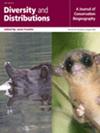Partitioning Beta Diversity at Two Spatial Resolutions Reveals Biotic Homogenisation With Habitat Degradation
Abstract
Aim
Understanding the effects of habitat degradation on biodiversity is essential for undertaking conservation initiatives, but commonly used metrics of biodiversity, like species richness and beta diversity, can miss important signals of change. Greater insights can be gained by partitioning beta diversity into nestedness, which relates to species loss, and turnover, which relates to species replacement. To obtain a more comprehensive understanding of biodiversity change with habitat degradation, we investigate how nestedness and turnover vary when comparing assemblages from the same or different habitat degradation levels, and how assemblage aggregation resolution influences this relationship.
Location
Sweden.
Methods
We used beta diversity partitioning to assess lichen, fungi and bryophyte species composition from 120 forest sites across Sweden, from three different habitat degradation levels, and at two aggregation scales (pairwise local assemblages and assemblages pooled at the habitat degradation level across our study sites). We examined how pairwise total beta diversity, nestedness and turnover varied when comparing assemblages from sites of either the same or different habitat degradation levels. In addition, we examined the relationship between total beta diversity, nestedness and turnover when assemblages pooled at the habitat degradation level were compared.
Results
We detected a small increase in pairwise lichen total beta diversity (Cliffs delta 0.40) and nestedness (Cliffs delta 0.19), but not in any other pairwise comparisons. In contrast, for all taxa, comparisons between assemblages pooled at the habitat degradation level showed higher values of nestedness and lower values of turnover than the corresponding pairwise comparisons, suggesting biotic homogenisation in highly degraded sites.
Main Conclusions
Our results highlight the importance of considering biodiversity change across multiple spatial resolutions to fully capture the effects of local species replacements in highly degraded habitats on biotic homogenisation.


 求助内容:
求助内容: 应助结果提醒方式:
应助结果提醒方式:


